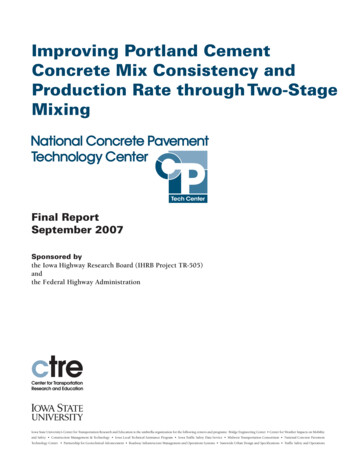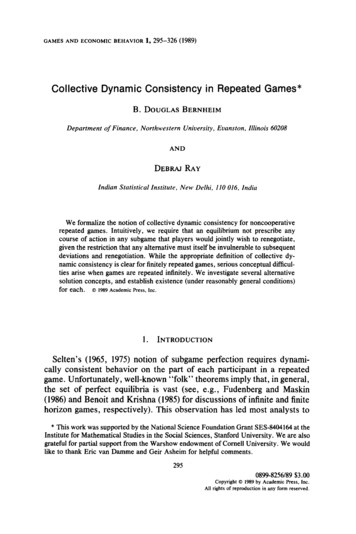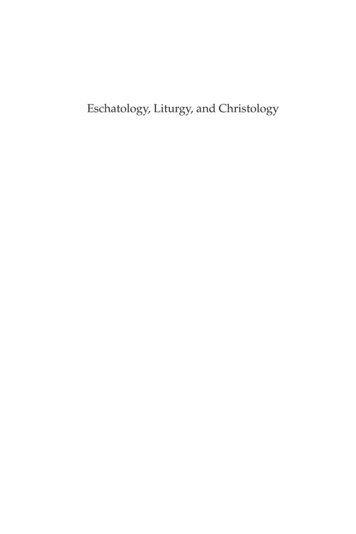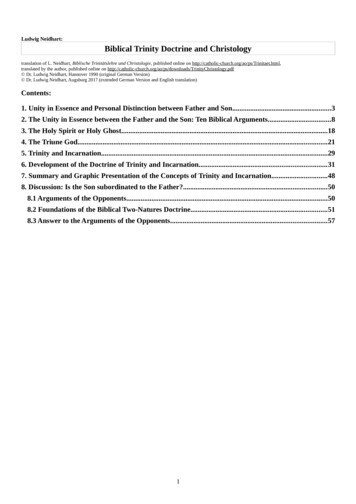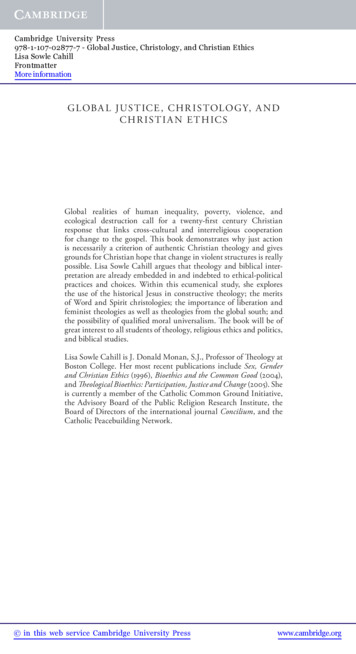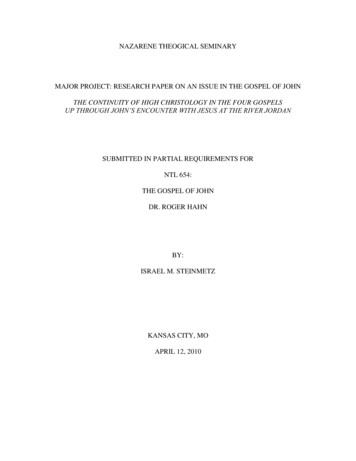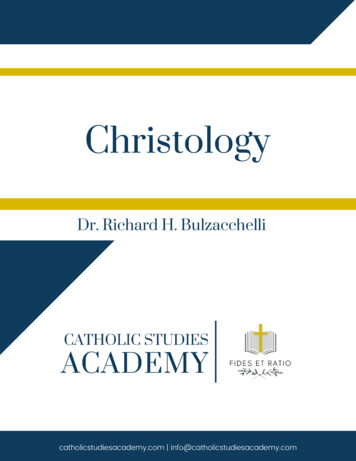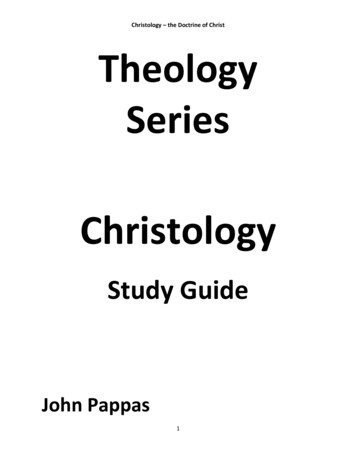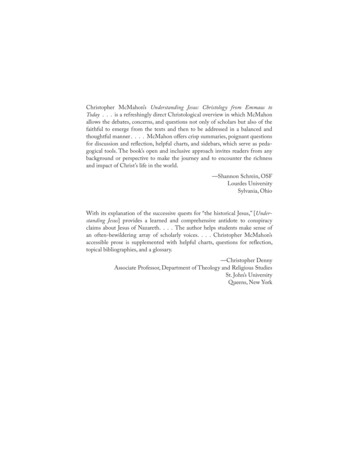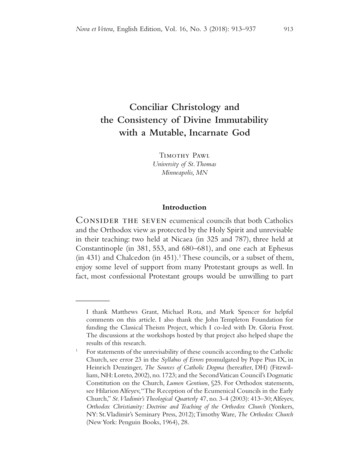
Transcription
Nova et Vetera, English Edition, Vol. 16, No. 3 (2018): 913–937913Conciliar Christology andthe Consistency of Divine Immutabilitywith a Mutable, Incarnate GodTimothy PawlUniversity of St. ThomasMinneapolis, MNIntroductionConsider the seven ecumenical councils that both Catholicsand the Orthodox view as protected by the Holy Spirit and unrevisablein their teaching: two held at Nicaea (in 325 and 787), three held atConstantinople (in 381, 553, and 680–681), and one each at Ephesus(in 431) and Chalcedon (in 451).1 These councils, or a subset of them,enjoy some level of support from many Protestant groups as well. Infact, most confessional Protestant groups would be unwilling to part1I thank Matthews Grant, Michael Rota, and Mark Spencer for helpfulcomments on this article. I also thank the John Templeton Foundation forfunding the Classical Theism Project, which I co-led with Dr. Gloria Frost.The discussions at the workshops hosted by that project also helped shape theresults of this research.For statements of the unrevisability of these councils according to the CatholicChurch, see error 23 in the Syllabus of Errors promulgated by Pope Pius IX, inHeinrich Denzinger, The Sources of Catholic Dogma (hereafter, DH) (Fitzwilliam, NH: Loreto, 2002), no. 1723; and the Second Vatican Council’s DogmaticConstitution on the Church, Lumen Gentium, §25. For Orthodox statements,see Hilarion Alfeyev, “The Reception of the Ecumenical Councils in the EarlyChurch,” St. Vladimir’s Theological Quarterly 47, no. 3-4 (2003): 413–30; Alfeyev,Orthodox Christianity: Doctrine and Teaching of the Orthodox Church (Yonkers,NY: St. Vladimir’s Seminary Press, 2012); Timothy Ware, The Orthodox Church(New York: Penguin Books, 1964), 28.
914Timothy Pawlways with the theology of the first four ecumenical councils.2 Thesecouncils provide the bedrock of the orthodox and universal teachingon the Incarnation of the Second Person of the Trinity. Let us call theconjunction of claims made at these seven councils concerning theChrist “conciliar Christology.”Conciliar Christology teaches that Christ, being divine, isimmutable. And yet, according to the same conciliar Christology,Christ, being man, changed. For instance, that immutable, divinePerson went from being born, to being baptized, then crucified,and finally resurrected. How can this be? For it seems that nothingimmutable can go from being one way to another, a point arguedby many thinkers both recent and ancient.3 I have argued elsewhere23See, for instance, John Calvin, The Institutes of the Christian Religion, trans. HenryBeveridge (Grand Rapids, MI: Christian Classics Ethereal Library, 1845), IV,ch. 9, no. 8; the Anglican Church in North America, “Jerusalem Statement,”no. 3, salem-statement;another statement form Anglican Church in North America website, ogy/; and the Episcopaldivine, Henry Percival, who wrote at the turn of the twentieth century, “Iwish to declare in the most distinct manner that I accept all the doctrinaldecrees of the Seven Ecumenical Synods as infallible and irreformable” (TheSeven Ecumenical Councils of the Undivided Church [New York: The ChristianLiterature Company, 1900], ix). For more discussion of the councils and theirauthority among the different Christian groups, see Christopher Bellitto, TheGeneral Councils: A History of the Twenty-One General Councils from Nicaea toVatican II (New York: Paulist Press, 2002); Joseph Kelly, The Ecumenical Councilsof the Catholic Church: A History (Collegeville, MN: Liturgical Press, 2009), 64;John R. T. Lamont, “Determining the Content and Degree of Authority ofChurch Teachings,” The Thomist 72, no. 3 (2008): 374–407; Norman Tanner,The Councils of the Church: A Short History (New York: Crossroad, 2001), 3–4, 7,13; Christian Washburn, “St. Robert Bellarmine on the Infallibility of GeneralCouncils of the Church,” Annuarium Historiae Conciliorum 42, no. 1 (2010):171–92; Jordan Wessling, “Christology and Conciliar Authority,” in Christology:Ancient & Modern, ed. Oliver D. Crisp and Fred Sanders (Grand Rapids, MI:Zondervan, 2013).For discussions of the logical compatibility of immutability and incarnation,as well as closely related discussions of the compatibility of incarnation withboth impassibility and atemporality, see Douglas Blount “On the Incarnationof a Timeless God,” in God and Time: Essays on the Divine Nature, ed. GregoryE. Ganssle and David M. Woodruff (Oxford: Oxford University Press, 2001),236–48 (see also the other essays in this edited volume); Daniel Castelo,“Moltmann’s Dismissal of Divine Impassibility: Warranted?” Scottish Journalof Theology 61, no. 4 (2008): 396–407; Richard Cross, The Metaphysics of theIncarnation:Thomas Aquinas to Duns Scotus (New York: Oxford University Press,
Conciliar Christology and the Consistency of Divine Immutability 915that such reasoning from immutability to the denial of Incarnation isflawed.4 I have also, in the same place, gestured toward a metaphysics that could help us understand, to the extent that we are able, animmutable, incarnate God.The goal of this article is to flesh out that initial understanding ofincarnational immutability. The method I employ to attain this goalis to consider cases of predications from the texts of conciliar Christology. I show potential ontological truth conditions for those predications being true that do not require the truth conditions I proposefor immutability to be unsatisfied. Put otherwise, I show ontological truth conditions for predications that imply Christ’s mutability42005), 215; Cross, “The Incarnation,” in The Oxford Handbook of PhilosophicalTheology, ed. Thomas P. Flint and Michael Rea (New York: Oxford UniversityPress, 2011), 452–75, at 464; Geoffrey Dunn, “Suffering Humanity and DivineImpassibility,” Augustinianum 41, no. 1 (2001): 257–71; Dunn, “Divine Impassibility and Christology in the Christmas Homilies of Leo the Great,” TheologicalStudies 62, no. 1 (2001): 71–85, Gilles Emery, O.P., “The Immutability of theGod of Love,” in Divine Impassibility and the Mystery of Human Suffering, ed.James F. Keating and Thomas Joseph White, O. P. (Grand Rapids, MI: Eerdmans, 2009), 27–76; Ronald Feenstra, “A Kenotic Christology of Divine Attributes,” in Exploring Kenotic Christology, ed. C. Stephen Evans (Oxford: OxfordUniversity Press, 2006), 139–64, at 142; Colin Gunton, “Time, Eternity andthe Doctrine of the Incarnation,” Dialog 21, no. 4 (1982): 263–68; JonathanHill, “Incarnation, Timelessness, and Exaltation,” Faith and Philosophy 29, no.1 (2012): 3–29; Richard Holland, God, Time, and the Incarnation (Eugene, OR:Wipf & Stock, 2012); Adrio König, “The Idea of the ‘Crucified God’: SomeSystematic Questions,” Journal of Theology for Southern Africa 39 (1982): 55–61;Jürgen Moltmann, The Crucified God: The Cross of Christ as the Foundation andCriticism of Christian Theology (Minneapolis, MN: Fortress Press, 1973), 214–15;Moltmann, The Trinity and the Kingdom:The Doctrine of God (Minneapolis, MN:Fortress Press, 1993), 22–23; John O’Keefe, “Impassible Suffering? DivinePassion and Fifth-Century Christology,” Theological Studies 58, no. 1 (1997):39–60; T. Evan Pollard, “The Impassibility of God,” Scottish Journal of Theology8, no. 4 (1955): 353–64; Herbert Relton, A Study In Christology (London:Society for Promoting Christian Knowledge, 1917), 54; Thomas Senor,“Incarnation and Timelessness,” Faith and Philosophy 7, no. 2 (1990): 149–64;Senor, “Incarnation, Timelessness, and Leibniz’s Law Problems,” in Ganssleand Woodruff, God and Time, 220–35; Richard Sturch, The Word and the Christ:An Essay in Analytic Christology (New York: Oxford University Press, 1991),33–34, 100–106; Thomas Weinandy, Does God Change? The Word’s Becoming inthe Incarnation (Still River, MA: St. Bede’s, 1985); and Frances Young, “A Cloudof Witnesses,” in The Myth of God Incarnate, ed. John Hick (Philadelphia, PA:Westminster Press,1977), 13–47, at 27.Timothy Pawl, In Defense of Conciliar Christology: A Philosophical Essay (Oxford:Oxford University Press, 2016).
916Timothy Pawland Incarnation that are also consistent with the truth of “Christ isimmutable.” Since the truth conditions for the incarnational texts donot require the falsity of the claim that “Christ is immutable,” theincarnational claims do not require the rejection of immutability. Inother words, the Incarnation is no reason to deny divine immutability, and vice versa.In this article, I will defend neither the claim that God becameman nor the claim that God is immutable. Similarly, I will notview myself as beholden to answer challenges to either claim on itsown, such as challenges to the possibility of Incarnation regardlessof whether God is immutable or not. No doubt, if such challengessucceed and the Incarnation is impossible, then any conjunctionof claims including the Incarnation is impossible too. You cannotremove a contradiction by adding more propositions to it. Be that asit may, such objections are not my target in this article, though theyhave been my target elsewhere.5 Rather, I will target objections thatbegin with either Incarnation or immutability and say that the onerules out the other, that you cannot have both.656For objections to immutability, see Timothy Pawl, “Divine Immutability,” inThe Internet Encyclopedia of Philosophy, ed. James Fieser and Bradley Dowden,2009, iep.utm.edu/div-immu/. For objections to Incarnation, see Pawl, “ASolution to the Fundamental Philosophical Problem of Christology,” TheJournal of Analytic Theology 2 (2014): 61–85; Pawl, “Conciliar Christology andthe Problem of Incompatible Predications,” Scientia et Fides 3, no. 2 (2015):85–106; Pawl, “Temporary Intrinsics and Christological Predication,” in OxfordStudies in Philosophy of Religion, vol. 7, ed. Jonathan L. Kvanvig (Oxford: OxfordUniversity Press, 2016), 157–89; Pawl, In Defense of Conciliar Christology; Pawl,“Truthmaking and Christian Theology,” Proceedings of the American CatholicPhilosophical Association 89 (2015): 181–94; and Timothy Pawl and Kevin Timpe,“Freedom and the Incarnation,” Philosophy Compass 11, no. 11 (2016): 743–56.It is a bit hard to spell out the exact sort of objections I am trying to ruleout here. Consider the sentence to which this footnote is appended. It is notquite right. For, one could start with incarnation and rule out immutability asfollows, if one thought incarnation were impossible. Begin with incarnation.That is contradictory. So anything follows from it. So the denial of immutability follows from it. Thus, incarnation rules out immutability. Such anobjection is not the sort of objection I want to consider in this article. I wantto consider objections that say, in a more straightforward sense, that somethingabout incarnation rules out immutability, where that something is not merecontradiction in the concept of incarnation.Likewise, one cannot simply begin by supposing that both incarnation andimmutability are possible and then ask whether they are compossible. For, tomany in the debate, God’s nature is necessarily as it is. So, if divine immuta-
Conciliar Christology and the Consistency of Divine Immutability 917I begin in my second section with a brief overview of the orthodox teaching of the immutability and Incarnation of Christ foundin conciliar Christology. Then, in my third section, I present someinterpretations of immutability.7 I do all the preceding in order tostage my fourth section, which provides metaphysically illuminatingontological truth conditions for some predications found in conciliarChristology. In the fifth section, I generalize from the cases I considerin the previous, providing a general account of how to deal withpredications truly said of Christ, according to conciliar Christology,in a way that does not impinge on divine immutability. Since theworld could be set up, I argue, such that the truth conditions for both“Christ is immutable” and “Christ suffered before he died” are true,it is false that Christ’s immutability, on conciliar Christology, implieshis inability to become incarnate. And it is likewise false, then, thathis Incarnation precludes his immutability.The Witness of Conciliar ChristologyThe conciliar texts say that Jesus Christ is one person of the Holy Trinity and has two natures: the one divine nature shared by all three divinePersons; and a particular human nature, which the councils claim to becomposed of body and soul.8 And, according to conciliar Christology,that human nature, the body and soul composite, has certain contingent features. For instance, Leo the Great, in his Tome to Flavian, whichwas accepted at the council of Chalcedon, states that the nature “washung, pierced with nails.”9 And again, the Church Fathers at Constantinople III write that “each nature wills and performs the things that are789bility were possible, it would be necessary. And if it is necessary, then God isimmutable in every world, including the possible world(s) where incarnationoccurs. So incarnation and immutability are compossible. Such an argument,again, misses the mark. It makes it too easy for the proponent of immutabilityand incarnation. My hope is that the reader can see what sort of objection Iam after in this article.For instance, see Pawl, “A Solution,” “Conciliar Christology,” In Defense ofConciliar Christology, and “Temporary Intrinsics.”For conciliar texts claiming that Christ is a person of the Trinity, see NormanP. Tanner, Decrees of the Ecumenical Councils (Washington, DC: GeorgetownUniversity Press, 1990), 5 and 86. For texts claiming that Christ had the twonatures in question, see Tanner, Decrees, 41, 44, 69, and 86. For texts claimingthat Christ had both a human body and a human soul, see Tanner, Decrees, 41,44, 55–56, 69, 86, and 115. For discussion of this textual evidence, see Pawl, InDefense of Conciliar Christology, chs. 1–2 and section II.b.Tanner, Decrees, 81.
918Timothy Pawlproper to it in a communion with the other.”10 The conciliar authors,then, are not afraid to predicate certain contingent states and activitiesof the human nature itself.11The human nature is “hypostatically united” to the divine naturein the person of the Son, is “assumed” by the person of the Son.12That hypostatic union is itself ineffable, on conciliar Christology.13We cannot exhaust an analysis of what it is, but we can understandwhat it does, at least in some circumstances. One thing it does is be thatthing in virtue of which the two natures are truly united togetherin the person of Christ. In virtue of this true uniting, some truepredications of the human nature are true also of the divine Person.For instance, because the human nature is hung, it is true to say ofChrist, the person, that he is hung. This is the ancient doctrine of the“communication of idioms.”The texts of conciliar Christology teach that the Second Personof the Trinity, the Word, Jesus Christ, was immutable even in thecontext of his Incarnation. There are multiple texts that one couldpoint to in support of this claim, but I will provide just two of them.14First, Cyril, Patriarch of Alexandria and the chief mover at the Council of Ephesus, wrote in his Third Letter to Nestorius:15101112131415Tanner, Decrees, 129.This is true not only of the conciliar fathers but also of very many peoplein the tradition. For instance, Athanasius (see Khaled Anatolios, Athanasius[New York: Routledge, 2004], 70–72, 140), Cyril of Alexandria (see Bellito,The General Councils, 24, and Relton, The General Councils, 56), Pope Leo theGreat (see Bronwen Neil, Leo the Great [New York: Routledge, 2009], 110),Martin Chemnitz (see The Two Natures in Christ [Saint Louis, MO: Concordia,1971], 191, 216), and Thomas Aquinas all predicate of the human nature thus.Aquinas calls the assumed human nature visible (Summa theologiae [ST] III, q.8, a. 1, ad 3), passible (ST III, q. 14, a. 1, ad 2), corporeally defective (ST III, q.14, a. 3, ad 2), etc.On assumption and hypostatic union being different, see Aquinas, ST III, q. 2,a. 8.Tanner, Decrees, 72, 117.For a more thorough discussion of conciliar Christology’s teaching of divineimmutability, as well as the teaching of divine immutability in other confessional statements, see Pawl, “Divine Immutability,” and In Defense of ConciliarChristology, 16–18, 181–84.This letter was accepted at the Council of Ephesus, and so is part of conciliarChristology. For more on the interesting topic of the acceptance of this letterin ecclesial history, see Thomas Graumann, “‘Reading’ the First Council ofEphesus (431),” in Chalcedon in Context: Church Councils 400–700, ed. RichardPrice and Mary Whitby (Liverpool, UK: Liverpool University Press, 2011),
Conciliar Christology and the Consistency of Divine Immutability 919We do not say that his flesh was turned into the nature of thegodhead or that the unspeakable Word of God was changedinto the nature of the flesh. For he (the Word) is unalterable andabsolutely unchangeable and remains always the same as the scripturessay. For although visible as a child and in swaddling cloths, evenwhile he was in the bosom of the virgin that bore him, as Godhe filled the whole of creation and was fellow ruler with himwho begot him.16Here we see Cyril affirming that the person of the Word, the personwho became incarnate, even while incarnate, was “unalterable andabsolutely unchangeable.”In addition, Cyril writes in a letter to John of Antioch that was alsoaccepted by conciliar Christology in the Definition of faith from thecouncil of Chalcedon:17God the Word, who came down from above and from heaven,“emptied himself, taking the form of a slave,” and was calledson of man, though all the while he remained what he was, thatis God ( for he is unchangeable and immutable by nature).18Here we see that God the Word, the very same Person as Jesus Christ,while incarnate, remained God, being “unchangeable and immutableby nature.”Both of these texts teach that the Word became incarnate. Furthermore, both teach that, while incarnate, he was immutable. This is notmerely a claim about the divine nature, as both texts make clear thatthe term is predicated of the incarnate person of the Word (that said,the divine nature is also called immutable on the same page as theimmediately preceding quotation).16171827–44, at 36; Edward R. Hardy, Christology of the Later Fathers (Philadelphia,PA: Westminster John Knox Press, 1954), 349; Edward Landon, A Manual ofCouncils of the Holy Catholic Church, 2 vols. (Edinburgh: John Grant, 1990),1:201; Richard Price, “The Council of Chalcedon (451): A Narrative,” inPrice and Whitby, Chalcedon in Context, 76, 85; Price and Whitby, Chalcedon inContext, 11–22; Tanner, Decrees, 37–38; On the Person of Christ: The Christologyof Emperor Justinian, trans. Kenneth Paul Wesche (Crestwood, NY: St.Vladimir’sSeminary Press, 1997).Tanner, Decrees, 51 (emphasis added).Tanner, Decrees, 85.Tanner, Decrees, 72 (the parenthetical is in Tanner’s translation, but the addedemphasis mine).
920Timothy PawlHow, then, might one understand immutability and Incarnationsuch that conciliar Christology is not contradicted and yet we havea stable metaphysical interpretation of how an immutable Christ cango from being one way to being another? In the next section I discussmultiple ways one might understand immutability.Some Understandings of ImmutabilityTo my mind, there are two errors to avoid when considering what thesecouncils intend to teach when they teach that Christ is immutable.One view that I have argued against elsewhere is that immutabilityrequires that anything immutable cannot in any way, in any fashion,no matter what, change. Call such a view super-duper immutability. Onthe other end of the spectrum, weak immutability can be understoodas the view that the only sort of immutability that the divine Personshave is immutability with respect to moral constancy.19 Christ, then, inbeing immutable, is not fickle or morally inconstant. Weak immutability denies any stronger immutability of the person in question. In thefollowing paragraphs, I argue that both of these views of immutabilityfail as an interpretation of the conciliar texts.As an interpretation of the conciliar teachings, super-duper immutability is wrong-headed, as it is inconsistent with explicit teachingstaught at every ecumenical council. Those teachings are included inthe Nicene Creed, which states that Christ suffered, died, and wasburied. Suffering, though, implies change, as does death. Thus, it isfalse that he did not change in any way, in any fashion, no matterwhat. The aptness conditions for being super-duper immutable, then,are not met by Christ, though they are met by the divine nature,since that thing, on conciliar Christology, cannot change in any way.Thus, super-duper immutability is not what the conciliar fathersintended to teach when, in the same texts, they taught that Christwas immutable.Consider, then, weak immutability. It is no doubt true of Christthat he was morally constant. But weak immutability does not19For discussions of weak immutability, see Isaak Dorner, Divine Immutability: ACritical Reconsideration (Minneapolis, MN: Fortress Press, 1994); Jay W. Richards, The Untamed God: A Philosophical Exploration of Divine Perfection, Simplicity,and Immutability (Downers Grove, IL: IVP Academic, 2003), 198–99; RichardSwinburne, The Coherence of Theism (New York: Oxford University Press,1993), 219; Robert R. Williams, “I. A. Dorner: The Ethical Immutability ofGod,” Journal of the American Academy of Religion 54, no. 4 (1986): 721–38.
Conciliar Christology and the Consistency of Divine Immutability 921capture the full intent the councils had when asserting that Christwas immutable. We can see this clearly if we reconsider the work theclaim of immutability was put to in the councils. For instance, in thepassage from Cyril’s letter to Nestorius quoted above, he uses immutability as evidence for the falsity of the claim that the divine natureor the Word turned into a human nature, or vice versa. If immutability were only a claim to moral constancy, this would be a lousyinference, as moral constancy is insufficient as a reason for thinkingthat such transformations did not occur.20 Weak immutability, then,is also not what is being taught in the conciliar texts.Elsewhere, I have provided what I call “revised truth conditions” for the predicate “immutable,” suggesting that we ought tounderstand a thing’s being immutable in the following sense: “S isimmutable when S has a nature that is unable to change.”21 We canthen give a similar understanding of mutability: “S is mutable whenS has a nature that is able to change.” This revised truth condition forimmutability avoids the pitfalls of both the super-duper and the weakversions of immutability. Consider them in turn.As we saw above, the super-duper understanding of immutability is at odds with the conciliar texts because it precludes Christ’sgoing from, at an earlier point, being baptized to, at a later point,being crucified. The revised view, however, has no such implication. Christ can have a nature that is unable to change, which is thedivine nature, and yet still have a nature that is able to change in therelevant ways, his human nature. Thus, he can be aptly characterizedby both the predicates “mutable” and “immutable,” on the revisedtruth condition.Similarly, as we saw above, the weak view of immutability is atodds with the conciliar texts because it fails at supporting the inferences to which the fathers put the concept of immutability. Therevised view, however, has no such difficulty. On this view, Christ’sdivine nature is precluded from being able to change. Thus, thefollowing two inferences are comprehendible: (1) from divine immutability it follows that the Word cannot be changed into a humannature; (2) from divine immutability it follows that the divine nature2021I make this argument in more detail in In Defense of Conciliar Christology,108–9.Pawl, In Defense of Conciliar Christology, 174. These truth conditions are“revised” from a standard contemporary interpretation of the term that doesnot include a reference to a nature of the entity in question.
922Timothy Pawlcannot be changed when the divine person assumes human nature.Neither the super-duper nor the weak view of immutability, then,is a view that is consistent with the conciliar texts. In what follows, Iwill assume the revised truth conditions for immutability. I will notat every turn repeat that long phrase, “the revised truth conditionsfor immutability.” Rather, I will simply suppose that the reader iskeeping in mind the understanding of the terms I stipulate, with anoccasional reminder here or there.As I have presented the truth conditions for something’s beingimmutable, they require that thing’s having a nature that is unableto change. For the remainder of this article, then, I invite the readerto keep a hand atop the ontological buzzer. If I say something thatimplies that the divine nature goes from being one way to beinganother, push it. In having said such a thing, I will contradict myintention of providing an account of an immutable, incarnate person.In other words, the reader is invited to be on the lookout for anyinstance in which I deny, or say something that implies the falsityof, the super-duper immutability of the divine nature.22 (The divinenature fulfills the conditions for being super-duper immutable, eventhough the Second Person of the Trinity does not.)My goal is to spell out the truth conditions of conciliar claims suchthat none of them require some change in the divine nature. If I cansucceed in that, I can show that affirming the truths required for theChristian Incarnation story does not imply that the incarnate personwas not immutable. Since that is the thesis that I wish to defend, Iwill have made my case.Incarnational Predications and Their Truth ConditionsOne useful way to proceed, which I will follow in this section, is byexamples. After giving examples, I will move on in the next section toprovide a general theory of how to go about answering challenges tothe immutability of the Word that arise from incarnational claims thatare part of conciliar Christology.We can get a sense of the ways of understanding predicationsthat are apt of Christ by looking at the things said of him in creedalstatements from the ecumenical councils. Consider, for instance, the22The divine nature counts as having a nature that is unable to change in virtueof being a nature that is unable to change, and so fulfills the revised truthconditions for immutability as well.
Conciliar Christology and the Consistency of Divine Immutability 923Nicene-Constantinopolitan Creed 23 (which is often called simply theNicene Creed today, though it includes elements first introduced atConstantinople I). Here are thirteen things that council says of Christthat we can use as test cases to give an account of what sort of predications the Incarnation requires to be true: (1) Christ is the only-begotten Son of God; (2) Christ is born of the Father before all ages;(3) Christ is true God; (4) Christ is consubstantial with the Father; (5)Christ is creator of all things; (6) Christ came down from heaven; (7)Christ became man; (8) Christ was crucified; (9) Christ suffered; (10)Christ died; (11) Christ rose again; (12) Christ ascended into heaven;and (13) Christ will come again in glory. If these predications can allbe true of something that fulfills the revised conditions for immutability, then it seems to me that we will have a good framework fordetermining how to deal with other objections that arise specificallyfrom the conjunction of divine immutability and incarnation.The first four predications are true of Christ without reference tothe Incarnation. (The fifth is as well, but I save that claim for a separate discussion.) Even if Christ had not become incarnate, he wouldstill be the only-begotten Son of God, born of the Father, true God,and consubstantial with the Father. Perhaps we could not say thatChrist was born “before all ages” if there were no ages at all, andso that claim, as stated, requires there to be some temporal creation.Even still, temporal creation does not imply incarnation, and so thisclaim does not require the Incarnation to be true. Moreover, “priorto” need not be understood in a temporal sense.24 In fact, as we will2324Tanner, Decrees, 24.For some discussion of this point, see, for instance, St. Ignatius of Antioch in hisLetter to Polycarp (see John R. Willis and M. J. Rouët de Journel, The Teachings of the Church Fathers [San Francisco: Ignatius Press, 2002], 343), Gregorythe Theologian (see M. H. Alfeyev, Orthodox Christianity: Doctrine and Teachingof the Orthodox Church [Crestwood, NY: St. Vladimir’s Seminary Press, 2012],275), and St. Leo, who speaks of the Son, when becoming incarnate, beginningto exist in time, though remaining before time (ante tempora) (Tanner, Decrees,79). For contemporary authors discussing the historical and systematic case fordivine immutability, see M. H. Alfeyev, Orthodox Christianity, 142; Brian Daley,Gregory of Nazianzus (New York: Routledge, 2006), 133; Leo Davis, The FirstSeven Ecumenical Councils (325–787): Their History and Theology (Collegeville,MN: Liturgical Press, 1990), 49, 52; Ludwig Ott, Fundamentals of CatholicDogma, 4th ed. (St. Louis, MO: Herder, 1960), 36–37; Joseph Pohle, God: HisKnowability, Essence, and Attributes: A Dogmatic Treatise Prefaced by a Brief GeneralIntroduction to the Study of Dogmatic Theology (St. Louis, MO: B. Herder, 1911),306–13; Eleonore Stump, The God of the Bible and the God of the Philosophers(Milwaukee, WI: Marquette University Press, 2016).
Timothy Pawl924see below, there is good reason from the Nicene Creed itself notto understand Christ’s begetting from the Father in a temporal ormutable se
Conciliar Christology and the Consistency of Divine Immutability 915 that such reasoning from immutability to the denial of Incarnation is flawed. 4 I have also, in the same place, gestured toward a metaphys- ics that cou

